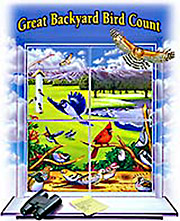Great Backyard Bird Count Feb. 16-19 asks computer users everywhere to capture information on avian life
By Allison Wells

Scheduled this year for Feb. 16-19, the 4th annual Great Backyard Bird Count (GBBC) asks volunteers to log on to the BirdSource web site at and tell scientists where the birds are.
The thousands of volunteer bird-watchers expected to participate this year are advised by the event's organizers, the Cornell Lab of Ornithology and the National Audubon Society, to be especially alert for several species that are showing population declines.
"We're asking everyone, everywhere in North America to take a few minutes and tell us what birds they see on any or all of the days," says John Fitzpatrick, director of the Cornell Lab of Ornithology. "By tracking changes in bird distribution and abundance over time, such a vast database can serve as the signal for species that may be in trouble."
More than 100,000 citizen scientists have participated in the GBBC since the event, which is sponsored in part this year by Wild Birds Unlimited and Ford Motor Co., began in 1998. GBBC 2001 will put the spotlight on quail, a family of birds familiar to many outdoor enthusiasts and a frequent backyard visitor in much of the United States and parts of Canada.
"Although most people recognize quail when they see them, few people are aware that some species, including northern bobwhite in the East and scaled quail in the Southwest, are experiencing severe population declines," says Frank Gill, National Audubon's senior vice president for science. "Because quail are relatively easy to identify, even the casual observer can play an important role in helping them by participating in the Great Backyard Bird Count."
Visitors to the GBBC web site can learn more about all six species of North American quail and about several species of woodpeckers, including the red-headed woodpecker and the northern flicker, that are showing signs of serious population decreases. Also new this year will be the GBBC's debut in several Latin American locations, allowing the count to reach a new region and affording scientists a glimpse of tropical backyards and the birds found in them. Because the GBBC charts findings in real time, scientists have already noticed some interesting connections between weather patterns and bird movements. For example, for the last few years, American robins appeared farther north than usual, in areas where snow cover was scant or nonexistent. Such a correlation might be caused by global warming or other broad-scale weather changes. This year's GBBC again will collect information about snow depth.
GBBC participants are asked to report the highest number of each bird species seen at one time (to ensure the birds are not counted more than once) and to keep track of the amount of time spent counting. They are then asked to log on to the BirdSource web site and click on the appropriate state or province for a checklist of the most frequently reported birds in that region.
Results are updated hourly in the form of animated maps and colorful graphs. Participants will be able to see instantly how their observations fit into the continentwide perspective. Findings from previous years also are available at the site.
In addition to results, the GBBC web site includes other information to make participation easy and enjoyable. The site has a vocabulary section, bird-watching and bird-feeding tips, bird vocalizations and more, including information about house finch eye disease. Bibliography and geography sections are available for educators, who are encouraged to conduct the count with students. Tips for planning and preparing a spring bird garden also will be included.
There is no fee or registration requirement to participate in the GBBC, and people without Internet access might be able to report counts at their local library. Many Wild Birds Unlimited locations also accept reports. Libraries, businesses, nature clubs, scout troops and other community organizations interested in promoting the GBBC or otherwise getting more involved can contact the Cornell Lab of Ornithology at 159 Sapsucker Woods Road, Ithaca, N.Y. 14850; or call (800) 843-2473 (outside the United States call (607) 254-2473).
Media Contact
Get Cornell news delivered right to your inbox.
Subscribe